Lebanese Baklawa Recipe calls for Turkish filo pastry sheets that are sandwiched with crushed pistachios sweetened with sugar and saffron, making it so irresistible. Melted clarified butter is brushed on top of the sheets and the cooled sugar syrup flavored with orange blossom water is drizzled on top of the hot baklawa to complete this lovely flakey, buttery-rich dessert!
One of my all-time favorite dessert recipes is the Lebanese Baklawa. You’ll notice that I call it baklawa and not baklava. The traditional pronunciation is ‘bak-lau-wa’ NOT ‘bak-la-va’. To some extent, these are interchangeable but one of the elements that I pay attention to when creating recipes is nuance. Nuance makes all the difference between a ½ cup of water versus a ½ cup of honey. When it comes to recipes, nuance and its cousin detail, matter. So, let’s begin with the first nuance.
I have tried and tested this recipe for many years, making tweaks all the way. I would try one method, just to find that it was either too sweet, too soft, too soggy or too dry. Browsing through cookbooks or magazines during the pre-internet years, I have learned many tips and tricks to get recipes done the right way. Besides word of mouth, I have searched through magazines, cookbooks, notes from family friends’ paper clippings, etc. to find answers to my kitchen mishaps.
I would then try a recipe again by using the new technique or ingredient that I read somewhere. If it worked, I would make notes and keep that method in my journals forever. It is with great pleasure that I am sharing the final finished product of all those trial and error on my part in the past many years trying to perfect one of my favorite desserts.
Origin of the types of baklawa or baklava:
The key thing to remember is that Baklawa is both Mediterranean and Middle Eastern. You can find versions of this decadent dessert from Greece to India. While it remains likely that the origin of this dough was in Turkey (yufka), the origin of the Baklawa can be traced to the 8th century BC to Assyria, where thin layers of bread dough were baked with nuts, fruits, and honey was added as a glaze. With the progress of trade and conquest, the ancient Baklawa has spread throughout the Mediterranean and the Levant.
It was not until the 15th century Ottoman Empire that attar was substituted with honey and served to the Janissaries during the Islamic holy month of Ramadan. This is the origin of the Baklava. With globalization and diaspora, even the Lebanese Baklawa’s recipe is now a global phenomenon.
The Baklawa and its cousin baklava share a lot of commonalities. First, they are both sweet desserts. If you are wondering why I called them sweet desserts, let me assure you that there are also savory desserts, such as desserts that contain cheese or chilis. They are both made from filo or phyllo pastry. They both contain nuts such as walnuts or pistachios, although there are even versions made of clotted cream. And they are both baked.
Differences between Lebanese Baklawa and Baklava:
Structure:
- Baklawa is essentially a sandwich of filo or phyllo pastry filled with a nut filling in the middle.
- Baklava is several layers of filo or phyllo pastry with a nut filling between the layers.
Glaze:
- Baklawa is glazed with attar. Attar, which is used everywhere from the Middle East to South Asia is a sugar-based syrup that contains a floral essence. This essence is usually made from rose blossoms or orange blossoms. Lemon juice is added to the syrup to prevent sugar crystallization. But from a flavor perspective, it adds an acidic dimension to the mixture, thus both heightening the flavor profile while also reducing the sweetness. For additional complexity, chefs sometimes add sweet spices such as cinnamon, cardamom, or even cloves.
- Baklava is glazed with honey. The flavor profile will alter based on the type of honey.
Frequently Asked Questions:
What is the difference between filo and puff pastry?
While they are both commercially available, the key differences are how they are prepared and the different fat contents in the dough. Phyllo dough has a lower fat content than puff pastry. Phyllo is made from flour, water, and vinegar and brushed with oil. The layering effect occurs when the thin dough is layered and baked. When one brushes this dough with melted butter, it becomes extremely flaky, which is the traditional baklava or baklawa crust.
Puff pastry is ‘laminated’ dough. The laminating process includes folding butter through the dough multiple times to create a thin, alternating layer of yummy buttery dough. This butter creates that puffy and airy texture when baked.
Why is this recipe called the Lebanese Baklawa?
It is a baklawa because I constructed a filo sandwich filled with pistachio nuts, and I used the attar as the glaze. It is Lebanese because I prefer making the baklawas lighter and mildly sweet, which is the hallmark of the Lebanese Baklawa as compared to the heavier Greek or Turkish varieties.
What is the difference between the Greek Baklava and the Lebanese Baklawa recipe?
Greek Baklava as I mentioned is honey-based, while the Lebanese Baklawa recipe uses sugar syrup with orange blossom water and lemon juice.
This post may contain affiliate links. As an Amazon Associate, I earn from qualifying purchases at no extra cost to you.
If you’ve tried this recipe or have questions, I would love to hear from you. Please feel free to share (below) your thoughts, comments, or any questions that you might have. And if you like my recipes, you could subscribe to my mailing list for the latest recipes that will be delivered to your inbox. From my pen to your table, Bon Appetit!
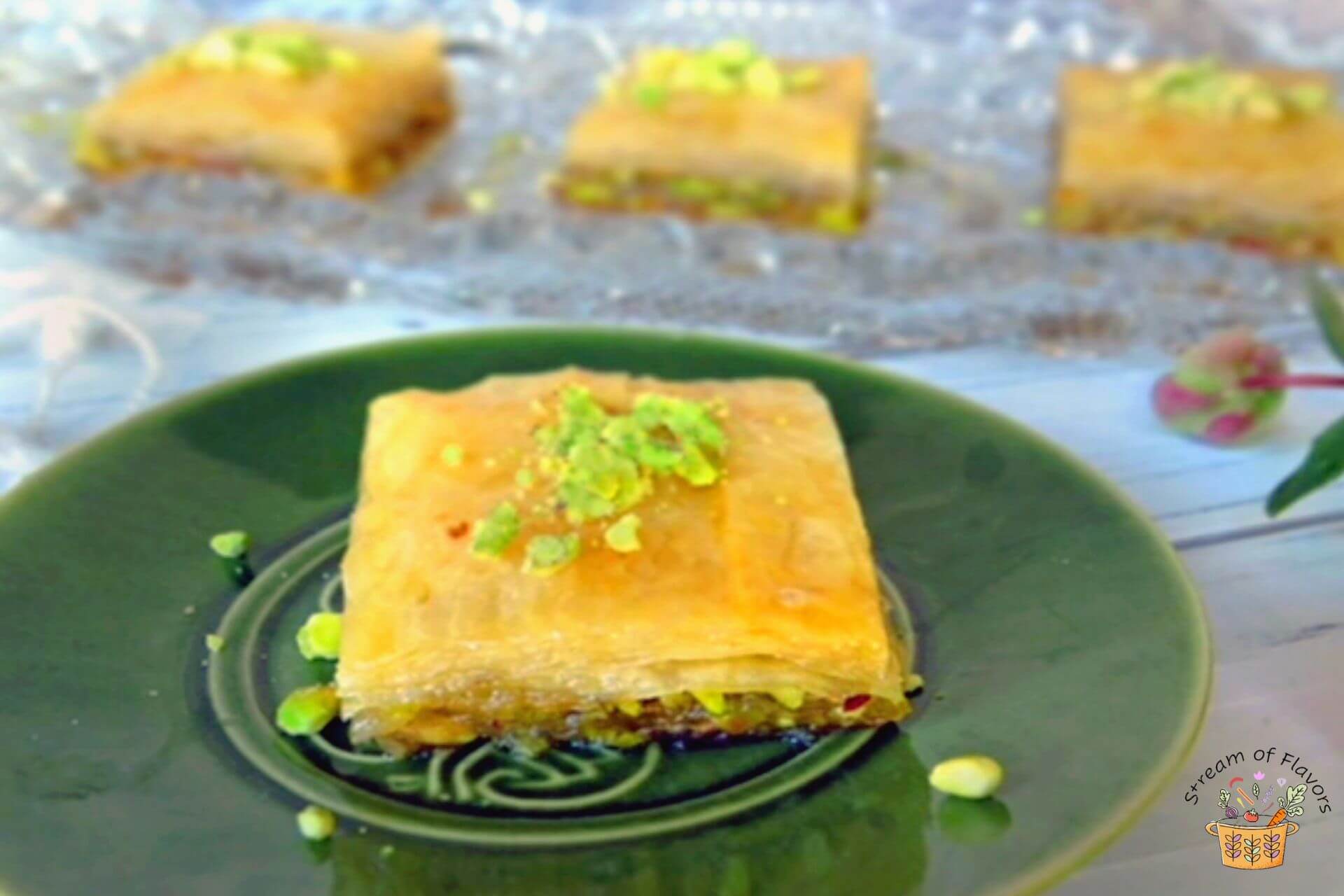
Ingredients:
- Sugar syrup: Ideally, granulated or caster sugar is used for the syrup. Orange blossom water or rose water is used to flavor the syrup. A dash of lemon juice is added to prevent crystallization. Feel free to add a whole cardamom while boiling the syrup.
- Filo pastry: I used the Turkish filo pastry sheets. Keep them covered with a damp kitchen towel to prevent the sheets from drying and breaking easily. You could buy the phyllo or filo sheets in the frozen aisle of your local grocery stores. Cut the sheets to fit the tray that you will using for the Lebanese Baklawa recipe. You will need to thaw the sheets if you buy the frozen pack. Trim the edges of the filo sheets using a pair of sharp scissors or a pizza cutter to fit snugly into the baking tray or dish that you choose to use. The edges of the filo sheets can be gently tucked in the baking tray or dish.
- Nuts for the filling: Walnuts are traditionally used, while you choose to make it with pistachios or cashew nuts. Chop them coarsely and make sure that they are unsalted. I spiced the pistachios with saffron, although even crushed cardamom seeds can be used.
- Clarified butter: Middle Eastern Baklawa is usually made with clarified butter (ghee) for brushing the sheets, but you could choose to use melted butter instead, even though it will not taste the same. I make both baklawa and baklava for my family, and they both use distinct methods and ingredients. Clarified butter is concentrated with just the fat as the liquid is evaporated in the heating process. The addition of clarified butter helps the Baklawa to be crispy. Over the years of experimenting with both types of this dessert, I have noticed that melted butter can make the baklava soggy and not as crunchy as the Baklawa that uses clarified butter. There are ways to get around this, but for this recipe for the Lebanese Baklawa, using clarified butter yields the best results.
Here are the step-by-step instructions on how to make this dish. Please refer to the recipe card below for the measurements.
How to make the Lebanese Baklawa using my recipe:
- Make the sugar syrup:
- Boil the water with the sugar in a pot and simmer for 15 minutes. Turn off the heat and add the orange blossom water and lemon juice.
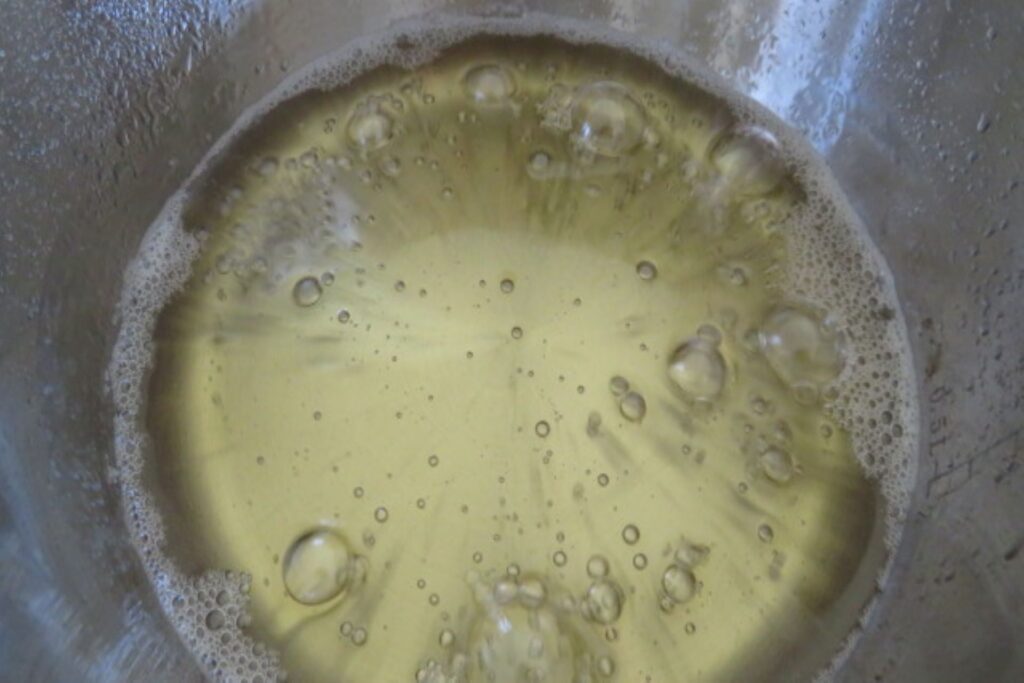
2. Mix the filling:
- Mix the pistachios with the sugar and saffron strands together and keep aside.
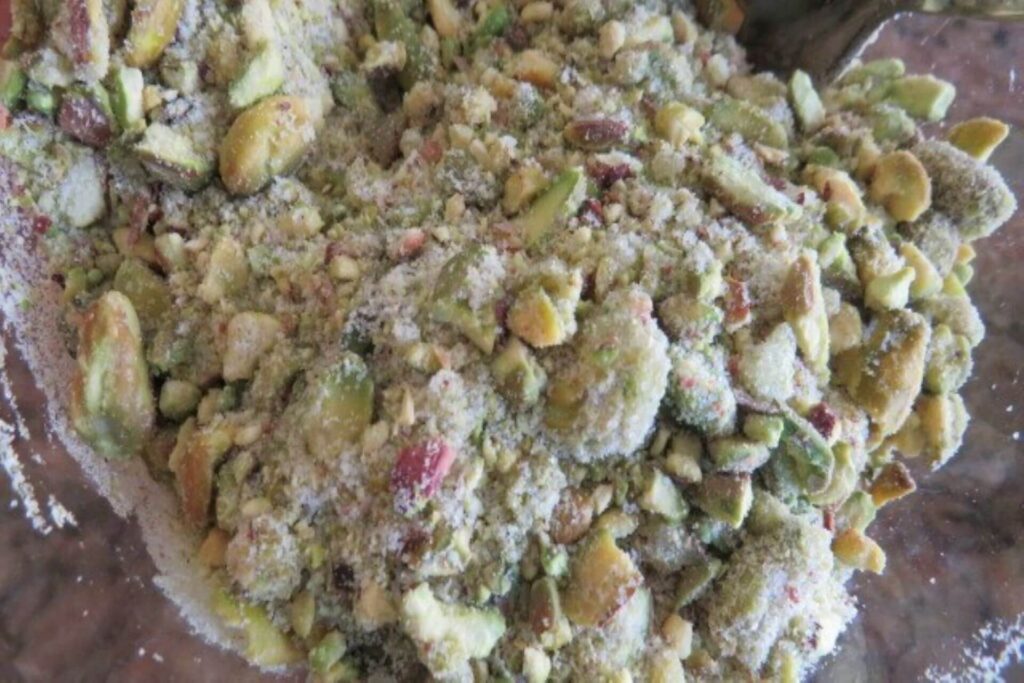
3. How to assemble the Baklawa:
- Grease a casserole or deep baking dish or tray. Lay 16 sheets, brushing with melted butter on top of each sheet.
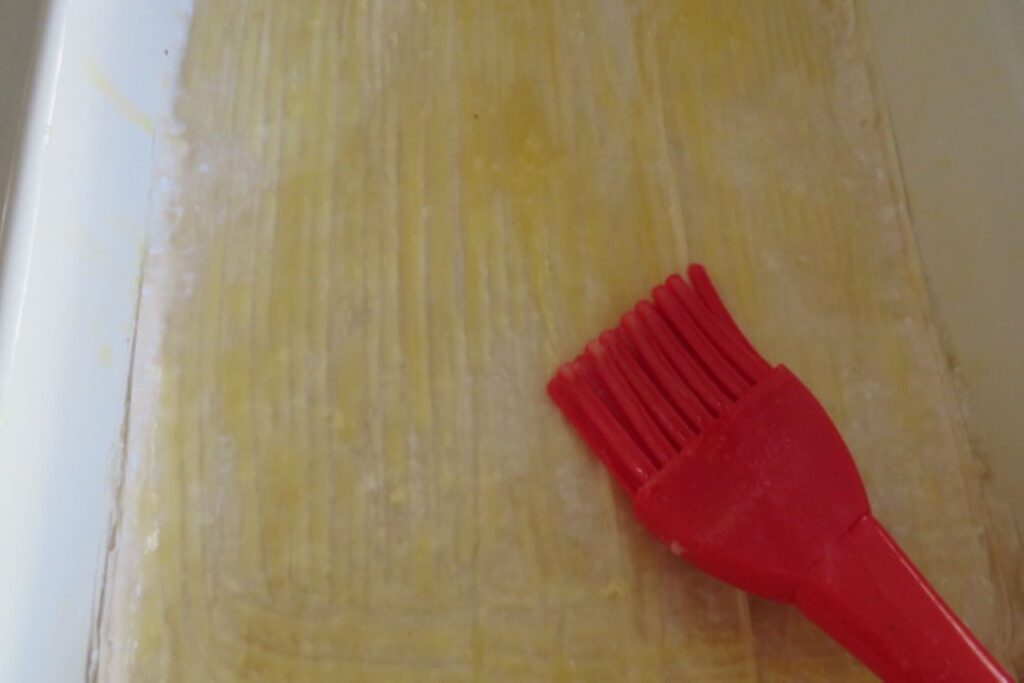
- Spread the pistachio-sugar filling mixed with saffron.
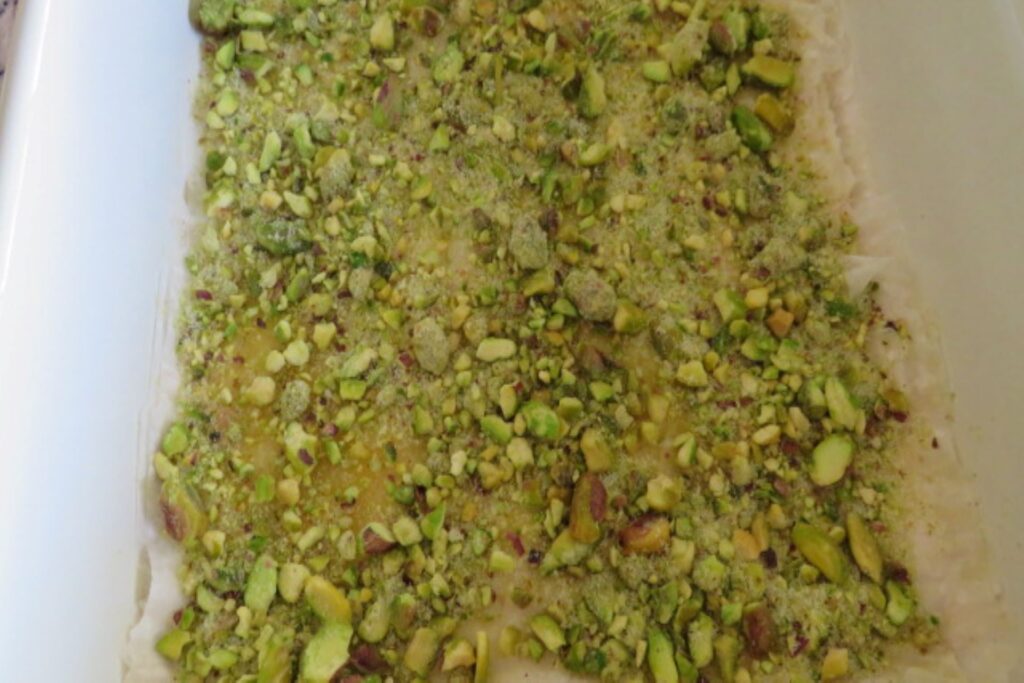
- Lay the remaining 16 sheets, brushing clarified butter between each sheet. Pour the remaining clarified butter on top. Use a sharp knife and cut all the way down to the bottom of the tray, while holding down on the top layers.
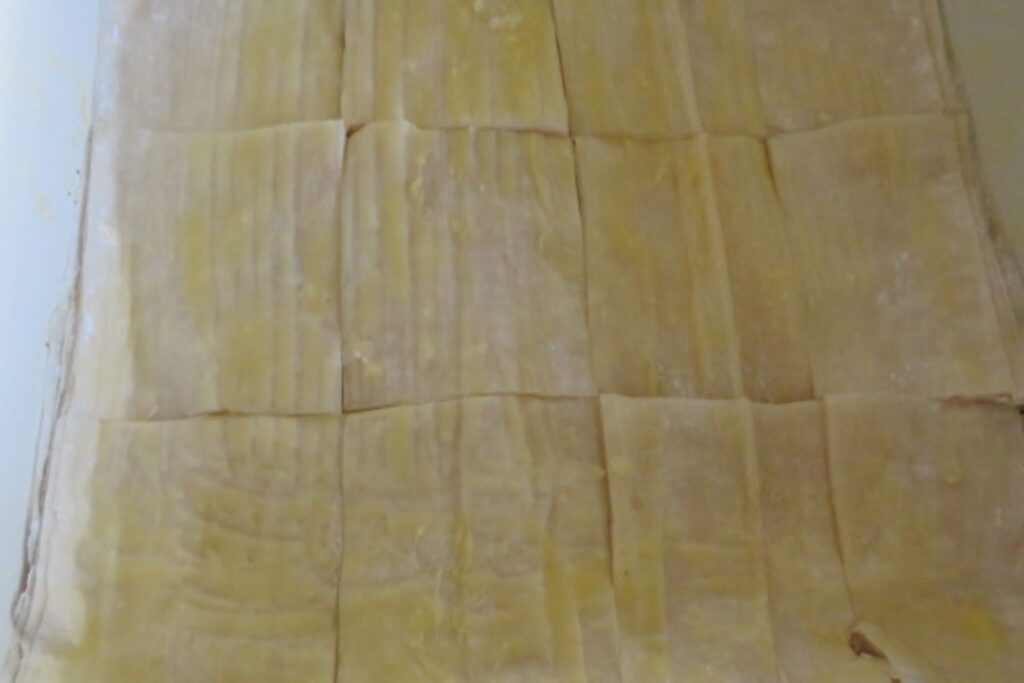
- Bake at 350 degrees F for 35-38 minutes or until golden brown.
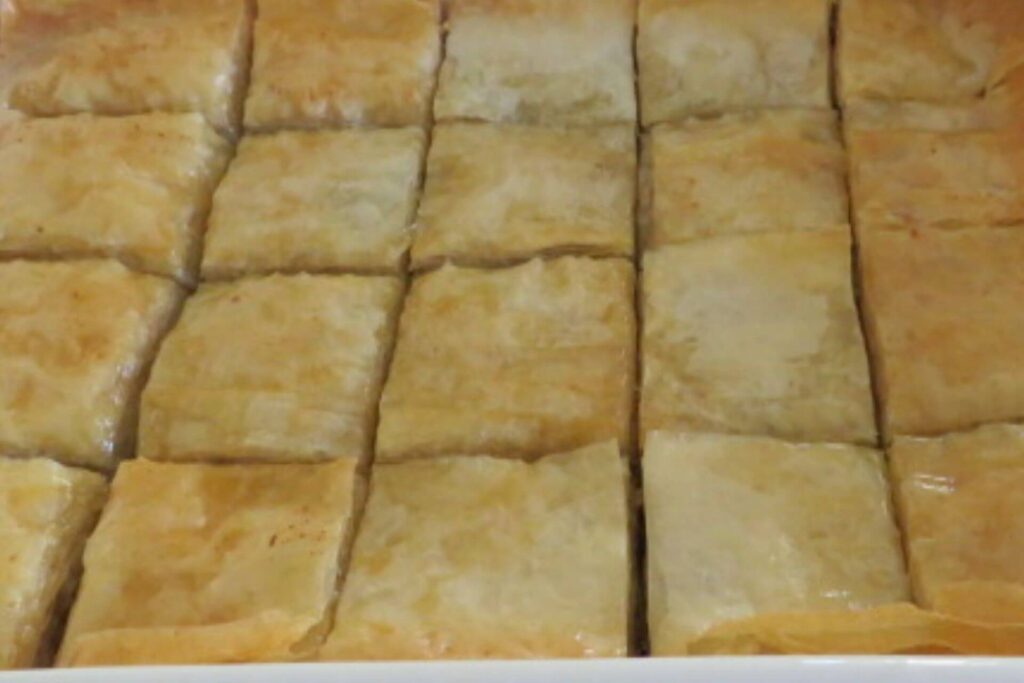
- Pour the cooled sugar syrup on top of the hot baklawa and let it cool for an hour before serving.
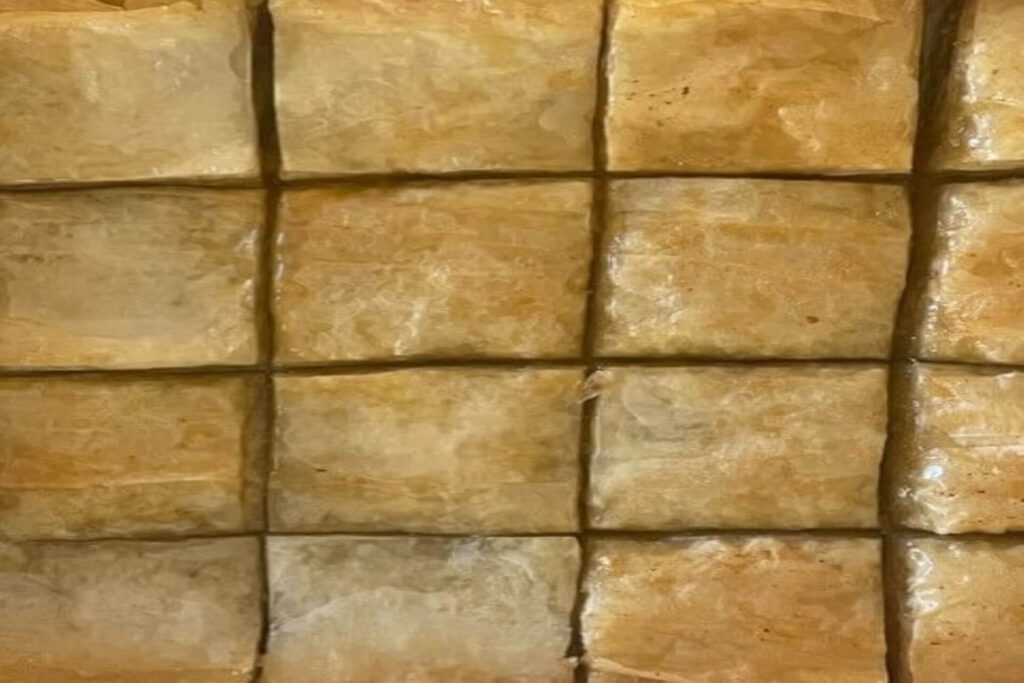
- Garnish with crushed pistachios.
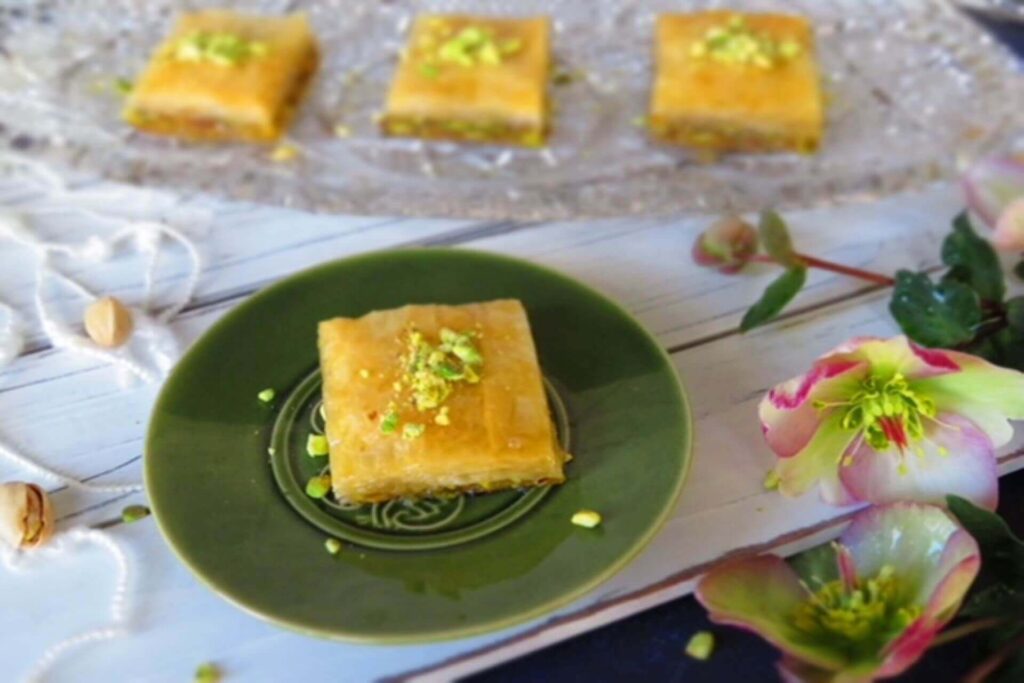
1. To prevent crystallization of the sugar syrup, add the lemon juice while simmering the syrup.
2. I have used a ratio of 1:1 sugar (1 cup) and water (1 cup) for the syrup for this dessert as it is traditionally meant to be less sweet. If you like it sweeter, then use 2 part sugar and one part water and boil the syrup for 3-4 minutes.
3. The filo sheets must be placed in a tray covered with a damp kitchen towel to prevent the sheets from drying and cracking or breaking.
4. I used a sharp knife to pre-cut the Baklawa down to the bottom of the tray. This step will help you with re-cutting the slices and make it easy to serve without torn edges. Use your palm to hold down on the top sheet of the pastry to make even cuts. A neatly cut slice of the Lebanese Baklawa will be easy to take apart after baking and look presentable while serving it.
5. I use cooled sugar syrup on the hot Baklawa (just like in my Greek Semolina Cake). Please allow the dessert to cool completely for an hour before re-cutting and serving it.
6. Brush with clarified butter between each sheet or between two sheets. The weight of the nuts will push down on the lower filo sheets and compact them, so you could use 20 sheets for the base and then sandwich them with the nuts and place the remaining 12 sheets on top (there were 32 sheets in this pack).
Serving suggestions:
The Lebanese Baklawa tastes great when served as a cold dessert or paired with hot Turkish coffee.
Storage:
Lebanese Baklawa stays fresh when stored in an airtight container at room temperature for two weeks. Leftover desserts can be frozen in airtight containers for three months.
Other dessert recipes that you might like:
Lebanese Baklawa Recipe
Equipment
- deep baking tray or dish, oven
Ingredients
For the sugar syrup:
- 1½ cup caster sugar
- 1½ cup filtered water
- 1 tsp orange blossom water
- 1 tsp lemon juice
For the filling:
- 2 cup pistachio coarsely chopped
- ¼ cup caster sugar
- ¼ tsp saffron strand
For the baklava pastry:
- 32 sheets phyllo pastry
- 10 tbsp melted clarified butter
Instructions
How to make the syrup:
- Boil the water with the sugar in a pot and simmer for 15 minutes. Turn off the heat and add the orange blossom water and lemon juice.
How to make the filling:
- Mix the pistachios with the sugar and saffron strands together and keep aside.
How to assemble the baklawa:
- Grease a casserole or deep baking dish or tray. Lay 16 sheets , brushing with melted butter on top of each sheet.
- Spread the pistachio-sugar filling mixed with saffron.
- Lay the remaining 16 sheets and pour the melted butter on top. Use a sharp knife and cut all the way down to the bottom of the tray.
- Bake at 350 degrees F for 35-38 minutes or until golden brown.
- Pour the cooled sugar syrup on top of the hot baklawa and cool for an hour before serving.
- Garnish with crushed pistachios.
Video
Notes
- Cut the Lebanese Baklawa into your desired shapes such as triangles or squares.
- Adjust the sweetness of the sugar syrup to your liking by adding more or less sugar.
- Since this recipe is for the Lebanese Baklawa which is basically a filo pastry sandwich with nuts and sugar syrup, I have layered the nuts between half of the total number of sheets.
- If you would like to stack more sheets for a taller baklawa, then increase the baking time and watch for the golden brown color on top.
Nutrition


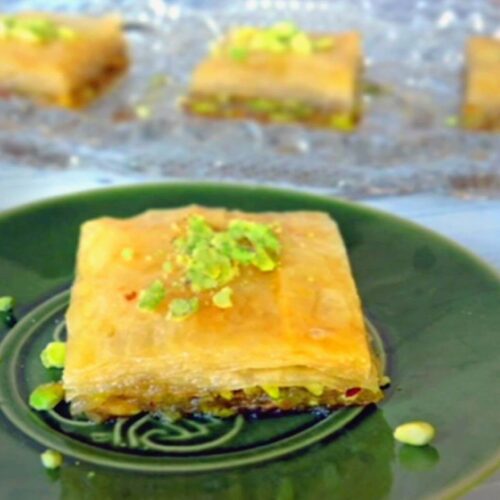
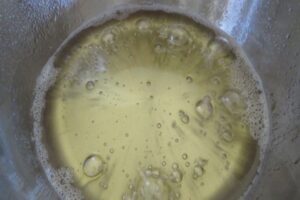
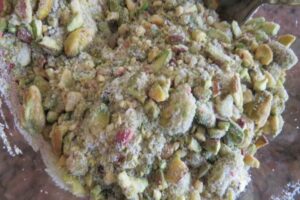
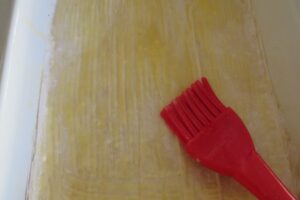
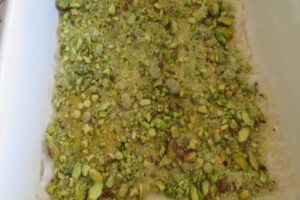
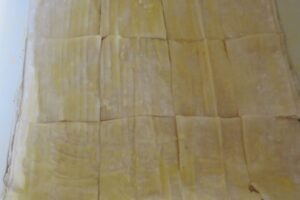
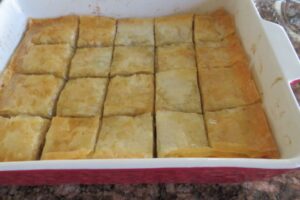
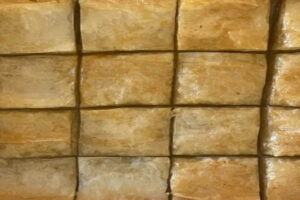
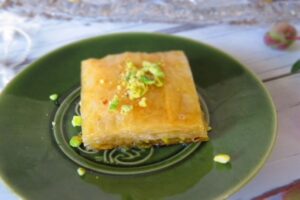




















0 Comments